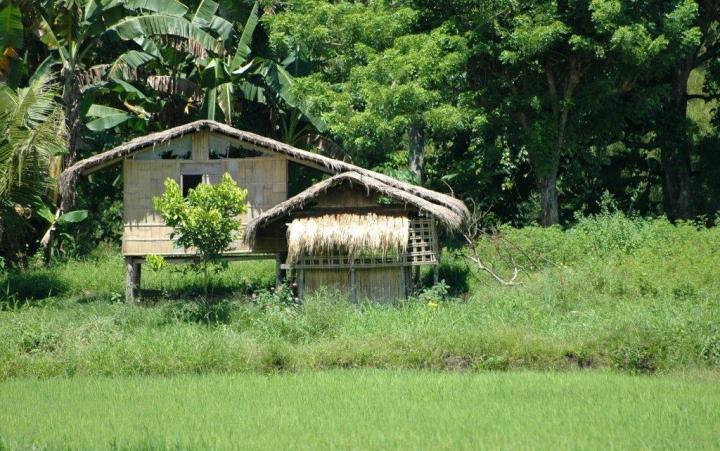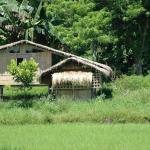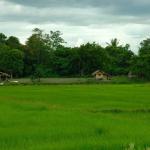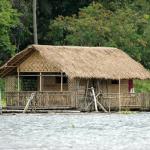Bahay Kubo
The Bahay Kubo is one of the most illustrative and recognized icons of the Philippines.
The name of the primitive Nipa hut is actually based on the Spanish phrase Cubo, meaning cube, probably because of its rectangular appearance and Bahay is the Filipino word for house. By tradition this type of village dwelling is constructed out of organic materials, a perfect example of a totally green structure, a showcase of extreme simplicity and sustainability that has been around for a very long time. The construction of a Bahay Kubo is totally based on the local needs and conditions. Fabricated with the ever dependable bamboo or kawayan and banded together by tree strings with dried coconut leaves or cogon grass. Walls are made of nipa leaves or bamboo slats and the floor is made of finely split resilient bamboo. The typical structure is raised with thick bamboo poles, one to two meters above the ground, depending on the area where the shelter is constructed, providing the inhabitants a safe shelter from wild animals, snakes and protecting them against torrential rains and floods. Bamboo is strong, lightweight and flexible; it has diverse, functional and traditional uses. It holds and mirrors much of the Philippine culture and it is part of many ceremonies, beliefs and traditions.
A Bahay Kubo is built to give a welcome refuge in the rainy season and provides shade in the hot summer. There are awning type windows on all sides, which will keep the interior well-ventilated, and that can be sealed off from the elements by a series of sliding panels. Its steeply sloping high-pitched roof shed rain and provides sufficient room for warm air to escape as a cooling air flow will enter through the porous bamboo walls and floor. The housetop is high inclined and open gabled to allow fumigation; it is fitted with wide overhang eaves, to provide shade from the hot sun and keeping the rain out. Some huts have an open back porch or batalan , used as a depository for water jars, a cellar or silong is used for most household chores and a silid or alcove for stashing the mats and pillows after use. The space underneath the house is used for ventilation and as a storage area for food, or sometimes as a shelter for small animals like goats and poultry. A distinct characteristic of the domestic Bahay Kubo is a kind of stairs or hagdan which can easily be disconnected at night and placed on the patio. Because the house is constructed with natural materials which are very inexpensive or most freely available in the near surroundings, it can quickly be rebuilt or repaired, using simple tools, if it is damaged or destroyed by fire or natural disasters like a typhoon or an earthquake.
This native homestead is typical for the Filipino concept of shared space and limited privacy, as a Filipino is friendly and very hospitable; a Bahay Kubo usually has no partitions for rooms. It is designed for family living and all household activities, like dining, recreation and sleeping, take place in one single, open and multi-purpose room called bulwagan. This quarter serves as an area for storage, as workspace and livestock pens, sometimes there could be a separate area for the kitchen. Surprisingly residents still have enough privacy to raise children and take care of the family, the sick and the elderly. A Filipino family likes to be surrounded by relatives all the time despite the turmoil sometimes created by their offspring and other members of the clan. Filipinos are known for their close family ties, they do not want to be separated from each other, even if the children are already married, their families are allowed to stay in the house or they will build their own Bahay Kubo next to the home of their relatives. It is custom that there should always be someone present in the house at any time. Coming to an empty house is not done; therefore it is out of the question to lock the front entrance of the house.
Life in a Bahay Kubo is not restricted by the walls of the house; it includes the live of neighbours and friends who often are considered as relatives. Solid communal ties will bring them together in giving aid to a family if a new house has to be constructed. It takes a reasonable large number of people to transfer the nipa hut, if the family wants to move to another place. This is done by putting bamboo poles length-wise and cross-wise under the house, forming a strong frame to lift the stilts from the ground and literally carry it to its new destination. Each man carries a piece of the weight of the Bahay Kubo and becomes a hero for all the others because he lightens the burden for them. This event holds a social and festive atmosphere, after the house arrived at its new site; the moving family shows their appreciation by hosting a modest fiesta for all volunteers that helped them. This collective activity is known as bayanihan, meaning unity and harmony; it demonstrates the unique culture and lifestyle of the Philippine community. It is taken from the word bayan which means community, nation or town and stands for a shared spirit that makes an apparently impossible endeavour possible through the strength of cooperation and solidarity. Bayanihan is an old and revered Filipino tradition, which signifies working together for the common good, giving each other unsolicited assistance out of a sense of closeness and camaraderie, especially during difficult times and without expecting recognition or personal gain.
In many places the traditional Bahay Kubo, the original ancestral home is replaced by modern structures, some of the original nipa huts can still be found clustered in barrios, scattered around the rural areas. In coastal areas nipa cottages are build on stilts in the water and on lakes a floating Bahay Kubo is used as a shelter for fishermen. At present it is very popular as a guesthouse, a romantic hideaway for lovers, a favourite ornament and recreational accommodation in private gardens and holiday resorts and as a playground for children. The shape and size has changed throughout the years, what remains is the desire for a collective space in an authentic Filipino style and feeling, evermore embracing the comforts of local tradition. The modern Bahay Kubo is used for family gatherings and is an ideal and pleasant place for blissful relaxation with neighbours and friends, sharing those bonding sessions while discussing family matters or the local gossip.
The idyllic house of the past stood the test of time and nature because it is totally adapted to the sometimes hazardous environment and assembled to withstand the country's, tropical rainforest climate which is characterized by relatively high temperature, high humidity and abundant rainfall. The humble Bahay Kubo is not only an indigenous house; it is an architectural and monumental masterpiece, considered as a national symbol, a cultural heritage and a token of togetherness. This time-honoured abode serve as a testament to the simple and clean but resilient Filipino spirit, it embodies the character of the provincial landscape in the Philippines and reflects the Filipino identity as well as the heart and soul of Filipino country life.
 ThingsAsian
ThingsAsian



















